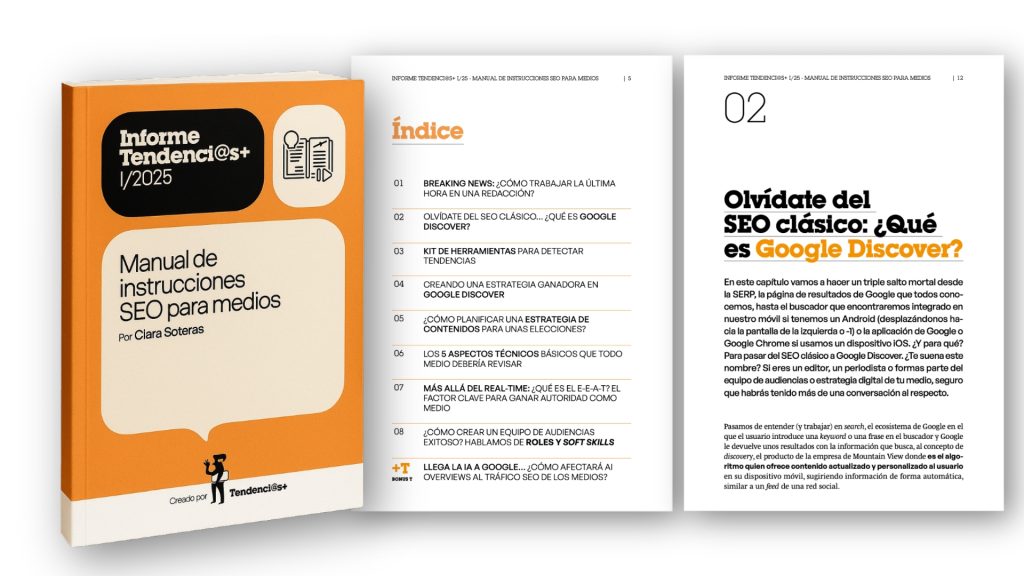GEO. LLMO. AEO. Or call it whatever you want, because SEO, finally, in 2025, is dead. We are entering the era of ‘generative engine optimisation’ or ‘answer engine optimisation,’ and if you haven’t yet changed the way you optimise your content and your website for search, now is the time to do so.
I could start this summer article by following the hype and the need for optimisation for LLMs and arguing that we have to perform a triple somersault to understand the new ranking factors and SEO work. But no, the generative heat wave we are experiencing has not affected me that much yet. In fact, and in the words of John Mueller, Google’s Search Advocate: ‘The greater the urgency and the wider the dissemination of new acronyms, the more likely it is that they are simply spam and a scam.’
So today I come to share with you my own vision of what we have been seeing and experiencing for months now in the media with the deployment of the AI Overviews, the latest Google core update, the umpteenth recalculation of the Google Discover algorithm, and the entry into the market of ChatGPT or Perplexity, new players that are changing the behaviour of our users. And what better way to do it than having an ice cream to lower the thermometer (physical and emotional) of these days, right? Will you join me?
Ice cream, yes, but… How do you want to take it? The new trend, multi-modal and multi-platform search
It is true that AI, now embedded within the user’s search experience, is here to stay, and our behaviour will never be the same again. We have moved from opening Google and typing in a query in the hope of finding a link with an answer, to snapping a photo of a plant on the path and asking the search engine whether it is poisonous, or using a voice command to request the best recipe for whatever happens to be in our fridge. This is multimodal search.
But at the same time, we have also begun to diversify our “searches”, knowing that to discover the latest summer nail art trends, TikTok will give us a better answer than ChatGPT or Google. Meanwhile, if we want to analyse some data from an Excel document, we might use OpenAI’s engine; and for a quick query like “supermarkets open near me”, we will turn to Google. Or if we are looking for opinions on a product we are considering buying, we will be interested in reading the reviews from those who already own it, on Reddit or Quora. This is multiplatform search.
And beyond the flavour of the ice cream, there is always a first choice to make: how do we want to eat it? In a cone or in a tub? Or perhaps you fancy an ice lolly, a popsicle or an ice cream sandwich instead? And of course, there will always be the nostalgic ones who remember a clean SERP without snippets — the true fans of the Frigopie.

Evergreen traffic is melting
Since the rollout of AI Overviews — Google’s own AI-generated answers within search — data, reports and studies have continually been shared showing a drastic drop in website clicks. This surge in evidence has been particularly noticeable since the introduction of AI Overviews in Europe at the end of March 2025. They were first launched in the United States, followed by the United Kingdom, and have gradually been rolled out across different countries, now reaching more than 100 worldwide. And yes, the early data first shared by Ahrefs in one of the initial studies has been confirmed. As expert Ryan Law reported, AI Overviews were cutting clicks by 34.5%. Far from being an exaggeration, this is proving true. Less than a month ago, Press Gazette highlighted a report from Enders Analysis, publishing that the majority of UK publishers had lost up to 80% of their visibility compared with 2019, citing major outlets such as the Financial Times, Telegraph, Guardian and Daily Mail. We are facing a generative heatwave that is melting our ice cream — or rather, our traffic. But wait. Not all ice creams melt at the same pace, so take note to make sure yours doesn’t disappear before it reaches the table.

We are already seeing it, and Google confirmed it as well this May at the World News Media Congress organised by WAN-IFRA in Krakow: it will continue to give priority to news and media outlets when it comes to current affairs and trending information. When we search for a news story of the day on Google, the search engine shows us the Top Stories module, displaying the carousel and linking through to publishers and the main homepage on desktop. This is the power of breaking news. A classic flavour, a safe bet, yet one that has been somewhat forgotten amidst all the new ones — pistachio, matcha, all-in mango or Dubai chocolate.
These days we can unfortunately see it when we search for the latest updates on the active wildfires in Spain. Google shows us an initial Top Stories carousel and up to two more from related organisations, but also adds a fourth carousel of Local News, as it considers the user’s location to be relevant to that search.
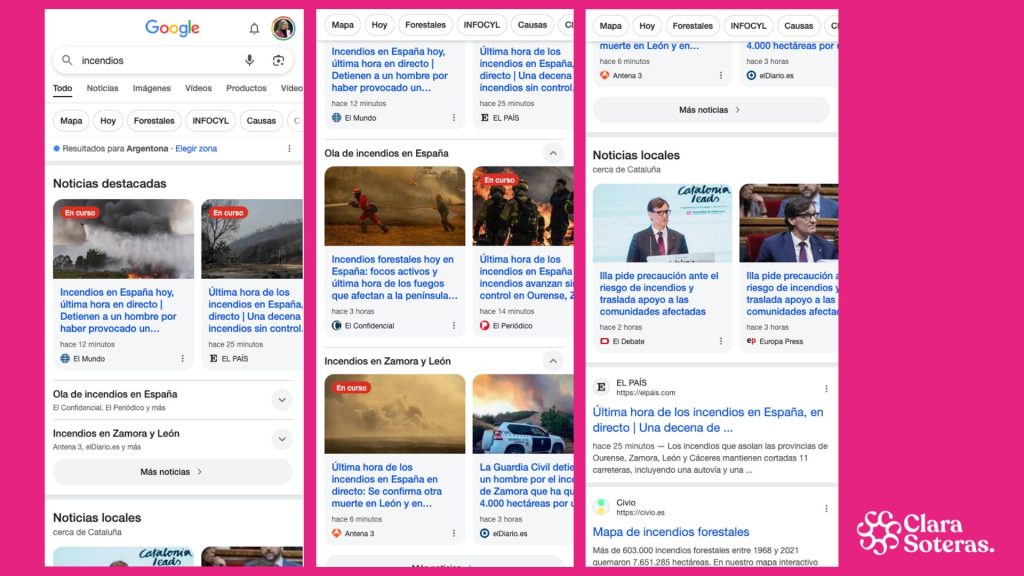
It’s something we see in all countries. Here are also examples of current affairs searches in the United Kingdom and France, where, as you can see, media carousels reappear.

Yes, this traffic is there, but it won’t last long. It’s not a timeless topic that we can rank for and that will generate page views repeatedly with nothing more than the initial effort. Nor is it that viral article you might find on Discover, designed to be the next summer trend and something you have to try — whether or not it’s at your favourite ice cream shop.
Evergreen traffic is melting. And we see this in every search. What we used to find in an article from a publisher or a blog post is now answered directly by AI Overviews: “how to take a screenshot,” “how to care for an orchid,” or “how to make mate,” and as you can see, the dropdown with the DIY tips is more than useful for getting the answer we need without having to click on any of the links at the end of the text.
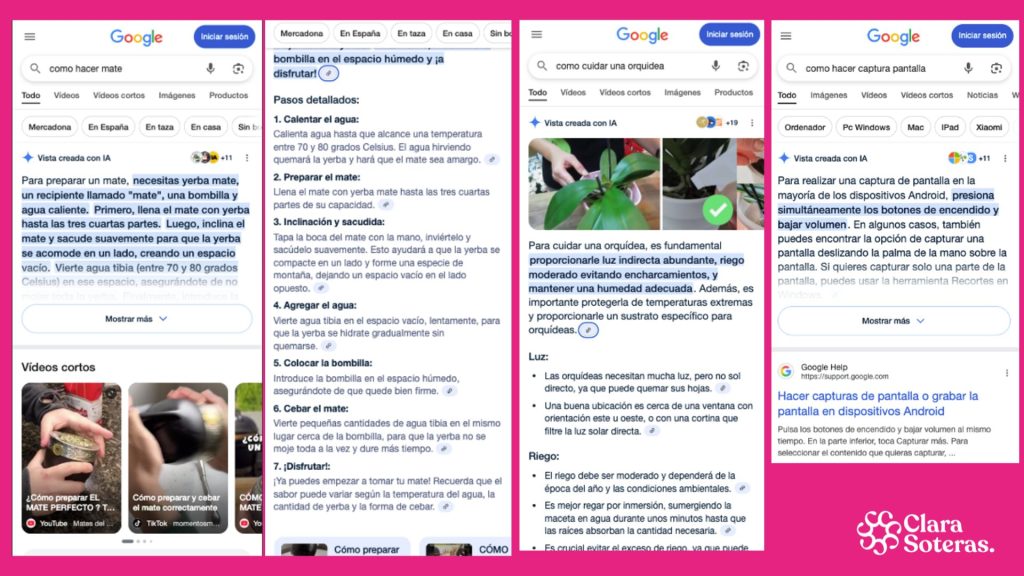
Google, in search of the next viral summer flavour: from AI Overviews to AI Mode
Google wants to give users their best search experience. It doesn’t want to provide the best link to a page for an answer. If it can answer you directly, it will do so (yes, using your secret recipe to get your homemade ice cream). But it has been signalling this for some time, and Google reiterates it in every communication. It’s nothing new, although now it wants to sell us the new flavours AI Mode and AI Overviews. Remember 0-click searches? Known as zero-click searches, they already accounted for more than 58.5% of all searches in 2024, according to data analysed by SparkToro. Why? What are these searches? They are queries that either receive a direct answer from Google via its knowledge panel or rich snippets (37.1%) or end because the user decides to perform another search (21.4%). On the other hand, those that actually get a click are only 41.5% of all searches, including organic results (70.5%), Google product results like YouTube or Maps (28.5%), and sponsored results (1%).

Looking at all this data, Google comes along and sits at the table to tell us it doesn’t quite see it the same way. It believes that “with AI Overviews, people search more and ask new questions, often longer and more complex. In addition, with AI Overviews, they see more links on the page than before. More queries and links mean more opportunities for websites to appear and receive clicks,” says Elizabeth Reid, Head of Google Search, in her latest post on the company blog. Exactly. It’s aiming to become the next viral summer flavour. But it’s obvious that the more flavours there are to choose from on the SERP (Search Engine Results Page), the less chance any one of them has of being picked, right?
And Google adds something more, while already working on the evolution of AI Overviews, the AI Mode that we are already seeing in the United States and the United Kingdom:
“Overall, the total volume of organic clicks from Google Search to websites has remained relatively stable year on year. In addition, the average quality of clicks has increased, and in fact we are sending slightly more quality clicks to websites than a year ago (by quality clicks, we mean those where users do not bounce quickly, which usually indicates genuine interest in the website). These figures contrast with third-party reports that erroneously suggest drastic declines in aggregate traffic, often based on flawed methodologies, isolated examples, or traffic changes that occurred prior to the implementation of AI features in Search.”
It’s not about quantity, but quality (of clicks). And here we could agree, but this is something that doesn’t work for the vast majority of media outlets, journalists, and content creators—at least for now. Monetisation still relies on volume, on the number of page views and unique users that allow them to sell programmatic or direct advertising, rank better or worse in rankings, and look better in the monthly snapshot that continues to underpin the financial foundation of many media outlets.
And now, the big question. How should the business model of media outlets change in order to continue practising journalism, delivering quality content, meeting the needs of our audience, and remaining financially sustainable? Let’s step out of our daily routine and head into the laboratory (or the kitchen).
How to rank as the best ice cream shop of 2025? The keys to remaining a sustainable media outlet while keeping Google happy
When the sea is calm, that unexpected wave comes and throws you off balance. Much the same way, almost without warning, the arrival of artificial intelligence has caused drastic drops and disruptions, overnight, in the percentages and volumes of organic traffic for some media outlets. The most affected, as we’ve seen earlier, are those that previously enjoyed stronger organic rankings, such as thematic niches and section verticals. Some have even lost more than 40% of their organic traffic, citing a figure mentioned by SEO consultant Barry Adams in an interview with Aleyda Solís.
1. Changing KPIs, understanding the business, and fostering customer loyalty
The most important thing now is to understand the need to go beyond simply measuring unique users and page views. There is a need to understand the business and think about the user and to know that if one day we can’t find strawberries at the market, we won’t be able to offer that ice cream flavour. But it is also vital to convey to CEOs, strategy directors, and digital departments of media outlets that the time has likely come to think beyond selling just one ice cream to the occasional tourist. Our KPIs need to change because we want our customers to become regulars, coming back for the ice cream of the week, becoming “ambassadors” of our shop, and returning with their friends.
That customer does not have the same value as someone who will never return or even remember our name. And isn’t it lovely when you’re satisfied with the service and experience, and you ask the name of your trusted ice-cream seller—the same person who, by next week, will already know what you want when they see you. But… who’s to say that one day this customer won’t come back asking for a horchata, or stop by for breakfast, or have a coffee after lunch? Are they coming back around? Yes, they are. Cherish them. Cherish me.
2. Being an authority, building your brand, and becoming a reference point
Just as a reader comes to read an article or opinion column by one of our journalists or contributors, being the leading media outlet in our field will also help us continue to grow, establish our own voice, and appear in the LLM showcase as a reference source. Therefore, taking care of our image and product, as well as the quality of our content, will help us move toward the experience and relevance that all media outlets strive for, earning the reward of hearing “I read it in (media brand),” even in the digital realm.
In fact, this should have been the case a long time ago, but the volume and pageviews brought to us by Discover have somewhat clouded our path. Now Google, precisely in its effort to boost the reputation of newspapers and digital outlets, and to continue gathering user information, has introduced the opportunity to highlight the websites we want to be part of our informative sources in Top Stories. Currently deployed only in the United States and India, users can now choose their “preferred sources.” Because getting on the preferred list of ice cream shops in your city is priceless.
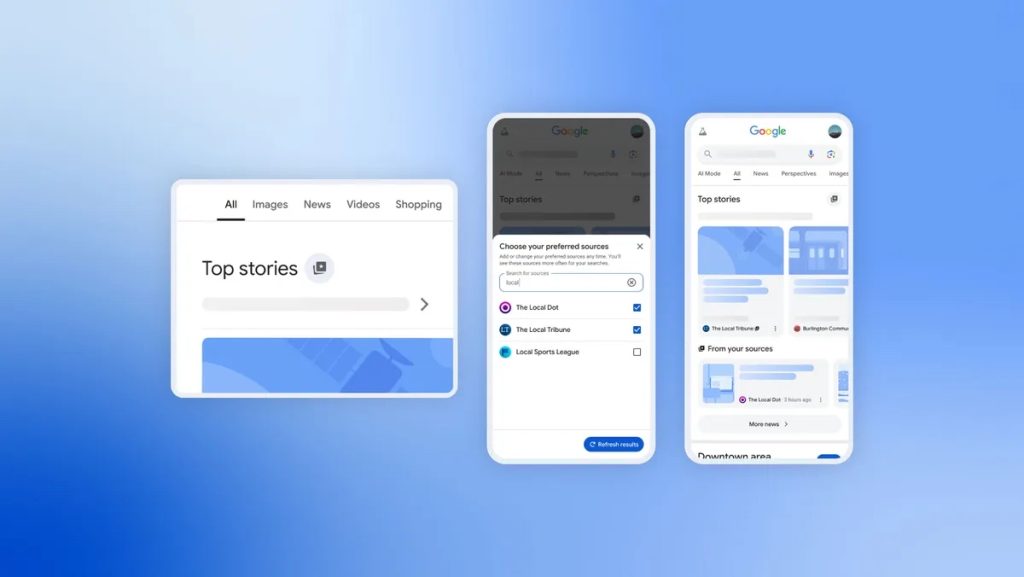
3. What does your customer need? Know your audience and provide them with valuable content
One of the things we most often forget when we are in the midst of the news whirlwind, trying to navigate the latest developments and daily life in a newsroom, is to ask ourselves: “What does our audience need?” And the truth is, the informational function of media is no longer the only one, and probably not even the main one at the moment, because being informed about something does not necessarily mean there is a need to consume any particular media. It is the core of the product and its raison d’être, but not the only aspect. With the diversification of sources, platforms, and free opportunities to access information, what we can offer our audience—and what they actually ask for—goes far beyond simply informing. Currently, citing the modelo de User Needs initiated by Dmitry Shishkin at the BBC, media organizations have the option to provide context, perspective, and analysis on a topic, but also to entertain the audience with games, like the great leisure product created by the New York Times, or the opportunity to offer services, such as the Cuban outlet El Toque, which created a website to provide the daily representative exchange rate of the informal currency market in the country, useful for understanding the real conversion of Cuban pesos against U.S. dollars.
But nowadays, media outlets have also learned to respond to the need to inspire and educate, offering content specifically designed for their audience, such as the Civil Eats newsletter, which helps explain the food issues in the United States and educates families on healthy consumption. And although we could continue listing needs, I will mention just one more: the need to feel part of a community, something that is also built on social media and enhances brand awareness.
And how is this done? By creating niche products, focusing on a local audience or on a specific content theme. A nearby example is Pamplonews, which started through a WhatsApp community to keep Pamplona residents informed and has now become a full-fledged media outlet offering services such as available parking spaces, bus schedules, or job listings.
And being able to answer the question posed in this point should be our first obsession. Because we will never be able to sell and retain our audience if we try to sell them an ice cream with a “cucurucho” when they don’t know what it is. Perhaps, in our client’s (user’s) jargon it is called a “cone,” or in some other regions, the term “barquillo” is even more commonly used.
4. Be unique and offer a memorable experience: 5 ice creams that will help you understand how to work on your E-E-A-T
Your slogan defines your identity. And Google will reward you for it. The well-known E-E-A-T (Experience, Expertise, Authoritativeness, and Trustworthiness), which in Spanish translates to Experiencia, Conocimiento, Autoridad y Confiabilidad, has long been part of SEO ranking factors and will continue to be, likely even more so in the coming months. It is the way to define ourselves and present ourselves on the web, to explain and demonstrate to crawlers and search engines (and now also to conversational ones) who we are, what we write about, and what we know—that is, our specialty. So being different and offering a memorable experience in our ice cream shop will surely help us grow. And you may ask, is this SEO? Yes, it is, and it will continue to be, even if it is one of the less-loved strategies by audience managers due to its hard work and the impossibility of measuring and isolating results. And since we still have days of “enjoying” the heat ahead, I bring you some examples of ice cream shops that have become unique for their product and value proposition (surely they are not the only ones, but here is my selection).
The POT chain presents itself as a shop of completely natural ice creams, or L’Atelier in Barcelona, where they invented the croissant cone with vanilla ice cream, salted caramel, and cookie pieces.
Or one of the new sensations trending on my Instagram, the Lebanese ice cream shop Azah, located in Barcelona, which has become famous for topping any ice cream with pieces of pistachios. And of course, they also have the Dubai chocolate flavor. We can’t leave out the panet de briox filled with ice cream and warmed up right before eating, invented at Rocambolesc, which can be enjoyed all year round.
And I must apologize, but I have to end this list by talking about the ice cream that has made this place famous and has already become an emblem of Mataró, a city 40 minutes from Barcelona (and no, I haven’t tried to make a Discover headline, even if it seems like it). It’s the biscuit with burnt yolk ice cream, eaten in slices, between cookie and cookie, from Granja Caralt. As you can see, be different, become the best with your product, and offer your audience what you do best.
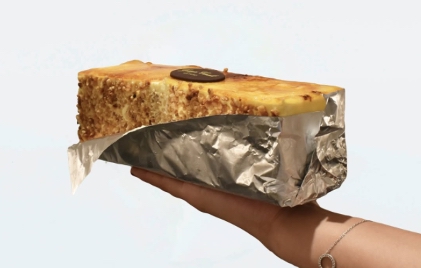
5. Where did you discover these ice cream shops? Work with influencers and get them to talk about you
In the same Google post we discussed a little while ago, it is stated that “more and more people are searching for and accessing sites with forums, videos, podcasts, and publications where they can hear authentic voices and first-hand perspectives.” We’ve said it before: the prioritization of user-generated content, that is, all those reviews that influencers or any user may make about products, services, or experiences, is going to be more important than ever because Google is giving them more relevance, also on the search results page, since, it says, that’s what the user is looking for. That’s why we see significant improvements in the visibility of forums like Reddit, where users can find “unique perspective or in-depth first-hand analysis,” as the tech company states, adding that “sites that meet these changing user needs benefit from this shift and generally experience an increase in traffic.”
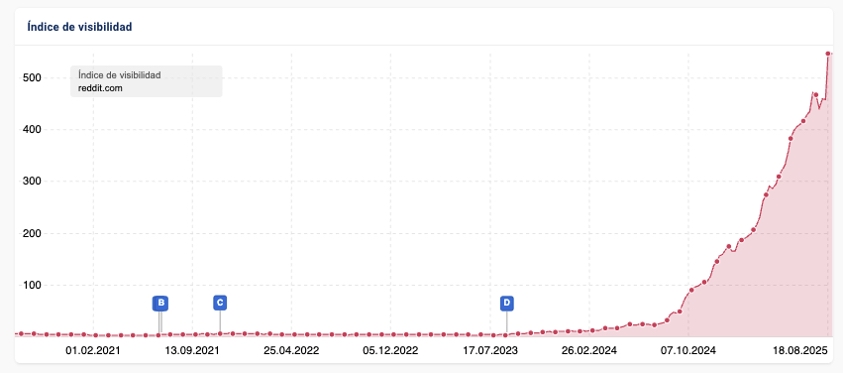
6. The sweetest touch always comes from Google Discover: Topping your ice cream with chocolate chips or an even better syrup
How could we leave out of this list the lever that has been feeding us the most in recent months? Yes, indeed, it’s Google Discover. As many of you know, it’s a completely volatile traffic source that Google almost never mentions and always calls “extra,” because yes, no one is obliged to add chocolate chips or syrup to your ice cream, but it makes it even sweeter. Google recommends that we do not base our strategy on Discover. While it’s true that it cannot be the only source of traffic or monetization for a media outlet, it is currently indispensable, and in my day-to-day work, it is the most common question from all my clients: “I want to appear more in Discover, what should I do?” Well, first of all, analyze which types of categories and entities you are strong in and are recognized as a reference by Google.
Knowing how to understand and work on your areas of expertise and your topical authority, involving the authors of each section in the content strategy and your editorial calendar, will be key. Not everything goes, as we saw after the latest core update in June of this year, where it’s no longer enough to publish just anything in any way; you have to understand very well the headline patterns and the consistency in content publication, clearly focusing on what we specialize in.

7. User Experience: nobody talks about the taste of that cookie
Too much advertising butter? Not crispy enough to finish it? Yes, the taste of that cone or cookie also affects your customer experience, no matter how good your ice cream is. It’s common to try to read an article and end up closing a thousand tabs, pausing autoplay videos, or trying to figure out how to make that banner disappear to continue reading. Well, that is also part of the user experience and one of the SEO ranking factors Google considers because if the user returns to the SERP or their Discover feed almost automatically, it’s a bad signal. It’s also not a good sign if our customer gets up from the table without finishing that cookie that came with their ice cream. Will they come back? Probably not.
8. The surprise reaction at the end of the ice cream: the melted chocolate
And if we talked about that element that can directly affect the perceived quality of our product, the same can happen—and positively—when your user reaches the tip of their cone or waffle and finds that melted chocolate. Here, you’ve surprised your user—they didn’t expect it and are left wanting more. It’s the perfect moment to offer them, if they’ve reached the end of that article, the opportunity to read more from that author or to subscribe to the newsletter or your publication, but always keeping in mind what they’ve just consumed. It’s pointless to try to retain a user who just read about the latest mortgage changes with a weekly cultural events newsletter. We are wasting opportunities for conversion and recirculation because we haven’t considered their interests and needs.
9. The Queue Effect: Working on Engagement and Community Building
We reach the end of this list, which is meant only as a starting point to rethink your strategy if you lead a media outlet or the content department of any brand or ecommerce in the coming months, with an eye on 2026. And in times of AI, the senses will continue to be just as important, if not more. We enjoy smell, touch, and, of course, taste. But in our business, vision also plays a key role: how many times have we noticed a store with a line of customers reaching around the corner? Well, yes, the queue effect in our ice cream shop will also generate curiosity among those who don’t know us yet. And here is where working with other departments such as social media or branding comes in, because SEO is no longer just about making our storefront look nice, but also about joining the strategy to attract new users (customers) through the engagement achieved on social media and community building. Remember, when you see a line at your ice cream shop, enjoy it — it means your team and colleagues are doing this cross-departmental work well.
From an Ice Cream to a Book
Surely, with this post I’m not helping Google much to understand what I’m writing about. Ice cream marketing? Hard to disambiguate. I’m not using perfect H2 or H3 headings with the intention of placing that keyword that will rank this next snippet, but I hope that, as the creator of this content, its new and recalculated algorithm will allow me to connect with those who want to go out for ice cream, try new flavors, without fear to innovate, grow, be unique, and ultimately create an editorial product that fulfills a user need—be it informative, entertaining, educational, or fostering community belonging. Create your ice cream and be unique. You know better than anyone who your customer is and what you can offer them each day so they come back to you tomorrow.
And now, while you think about what your next ice cream will be (and, best of all, at which ice cream shop you’ll enjoy it), I invite you to read a bit more about how to understand and work with SEO in media and the future of journalism and newsrooms in a less metaphorical way. With the “SEO Guide for News Publishers and Media Outlets” published by the Tendenci@s newsletter by Ismael Nafría. A book with a mango flavor if you follow the latest trends, or tangerine or orange if you like the traditional. And if you feel like continuing the conversation on this, I invite you to write me or to join the first presentation of this book, which I can already announce will be on September 16 in Barcelona, at the headquarters of the College of Journalists.
Thank you for reading all the way to the end and hanging in there without melting! P.S. I know I’ve probably created a new craving for you ;). You’re welcome, “ice cream shops near me.”
